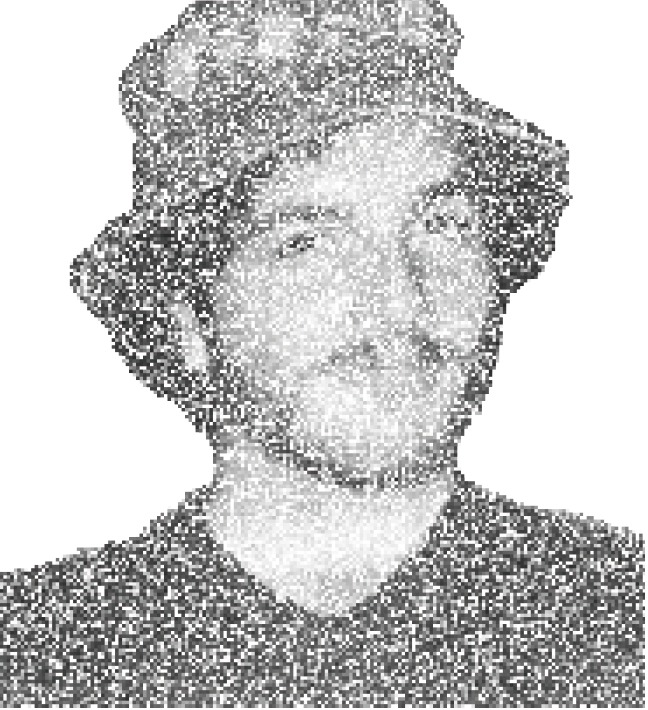
GABRIELLE ALDRICH
WOODCARVING ENTHUSIAST
In my backyard, there are two boxelder trees. Throughout the warmer months, these trees become more bothersome than beneficial. Boxelder trees attract boxelder bugs, harmless yet pesky insects that gather in large clusters on my Adirondack chairs and wooden picnic table. I find boxelder bugs throughout my house and yard, easily identifiable by the red streaks adorning their wings.
The branches of these trees are delicate and particularly susceptible to damage following storms. Even a gentle breeze can litter my yard with twigs. The boxelder’s pale, soft wood burns quickly and lacks utility for any noteworthy purpose. Last winter, a sizable branch crashed down in my backyard. I took it upon myself to break up the fallen limb, burning it incrementally. I sawed into the branch, only to be surprised by a flash of pink.
When the boxelder tree is harmed, the tree produces a red hue in the wood, called the tree’s “flame.” It is believed that this prevents the growth of fungus in the wood. To me, it looks like the tree is bleeding. The otherwise unremarkable wood becomes beautiful, streaking the grain with an unusual pink hue, reminiscent of the red on the boxelder bug’s wings.
As an amateur woodworker, the pink-colored flaw in the boxelder is what makes the wood special. Without the tree’s pink reaction to an environmental stressor, I would have just burned the rest of the fallen branch.
Currently, I’m carving with a piece of spalted yellow birch wood, which has thin black streaks— almost like veins— caused by fungi. Spalting makes the wood undesirable for structural purposes: the black lines mark where the wood is experiencing decay, but makes the wood valuable for aesthetic purposes.This phenomenon is common among woodcarvers: the most unique and beautiful wood is marked by flaws: weird grain patterns, discoloration, and burls. It gives the wood character.
FINN BROPHY
SENIOR LAURENTIAN
Although Canton, New York is near perfect, there are slight flaws with the Canton bar scene.
The Hoot Owl has everything it needs to be the perfect college bar, except for the attendance.
There are many “fake fans” of the Owl, and I am calling on my fellow Laurentians to become more avid customers at the North Country’s greatest bar.
Tuesday Senior Blues is one of St. Lawrence’s greatest traditions, and I hope this perfect tradition will be preserved and more Laurentians will come to the former train station to enjoy a cold (and cheap) bucket of Labatt Blue Lights. We have a few more weeks of school, and I hope my fellow seniors will do their part in maintaining this superb tradition. My greatest complaint about the Canton bar scene is the lack of a spot to grab a simple beer and bite.
Canton needs a place where Laurentians go to grab a crisp IPA and juicy burger.
The Stadium has a beautiful array of alcoholic beverages, but does not serve food, and therefore does not qualify as a “beer and bite” bar.
However, I do believe that the Stadium is an absurdly underappreciated bar.
If a spot that offers crispy, tasty beer with an assorted menu of food eventually opens, Canton will obtain the final “Infinity Stone” and truly become perfect.
The diminishing student attendance at the Hoot Owl, along with the swirling rumors of the Tick Tock Inn rebranding, makes me worried about the Canton bar scene.
I hope that my complaints will be addressed, and the fake-fans of the Hoot Owl realize its beauty and become season ticket holders. Maybe, one day, I will return to Canton and open the beer and bite spot that this North Country town greatly needs and deserves. Until then, let’s appreciate the trifecta of bars that Canton has to offer, and give them the business that they deserve.

KRISTEN WHITTIER
ADMINISTRATIVE ASSISTANT
To me, the word flaw has a negative connotation because it is defined as an imperfection that weakens an object or makes it less than.
As someone who enjoys creating art with my hands, flaws represent the beauty, character, strength, and humanness of a handmade object. When searching for pieces of stained glass, I am always looking for those sheets that are rough-rolled, bubble-filled, sagging or etched.
These flaws bring the glass to life with character, reflections, and unique features
The different dimensions of glass represent its creation, history, and age.
In my eyes, these perceived flaws bring the piece more value and only add to its character and therefore the overall beauty of the final project.
In many ways, this is how I think about life.
We are not perfect.
We all have flaws, scars and experiences that make us unique.
Human experience changes you, redefines you, and ultimately reveals the character within you.
When creating a work of stained glass, I fill it with many colors of imperfect glass, and it creates an overall picture that is ultimately beautiful, unique, and reflective.
Flaws do not weaken or make us less than. The flaws in all facets of our lives make us human.
MADYSON McCARTHY
THINKER
According to the Oxford English Dictionary, a flaw can be defined as “A defect, imperfection, fault, blemish. In material things, and figurative.”
This definition opens the gate for a range of interpretations, all of which are situationally contingent. In fact, flaws are entirely subjective, and the definition itself points out how they can operate both physically and metaphorically. It seems counterproductive to put so much emotion behind our flaws when, in reality, they are manufactured by us. They only exist because we allow them to.
Flaws inhabit many spheres, occupying material and figurative spaces, and can be attributed to a person’s character, appearance, or behaviors. However, the preferred character, appearance, or behavior of an individual is socially constructed. Western beauty standards put extensive emphasis on the ways that flaws make a person less desirable. If you are located anywhere outside of these fabricated norms, then you are essentially deemed to be flawed in some way.
This dangerous practice is perpetuated by the West’s obsession with consumerism. If you desire to alter your imaginary flaws, then in most cases, you will be guided towards a monetary solution. The consumer culture that has invaded our lives now functions on the basis of making people pay to correct what society decides is a less-than-perfect trait or quality.
One cannot open a social media app without seeing a skincare advertisement influencing viewers to buy a product for their blemishes, without any actual regard for the possible health problems that viewers [buyers] of this product may actually be experiencing. It is due to the fictitious nature of flaws, being that they are relative to time and place, that multiple industries and societal systems are able to capitalize on their artificial existence.

NOAH DONELLAN-DOSER
PROFESSIONALLY UNPROFESSIONAL
Flaws… we love them… we hate them…
Flaws scurry their way into our lives during the most trivial moments. Whether it’s a snapped thread whilst sewing up a faded pair of Dickies or gallivanting across fields of green only to trample into a loose pile of sharp needles. Casual flaws occur daily.
I, personally, am flawless. From my weak ankles to my sensitive love handles to my frail and tired scalp, I am perfectly perfect. My clothes fit just right; my steps align with the cracks in the pavement; my car always manages to have one gallon of gas left after a road trip from Boston to Canton. Perhaps, I’m simply too good – too flawless. But, of course, not everyone can see themselves in the same light. Flaws lend to haunt us. Mistakes we’ve made along the way follow us around every corner. A faulty break-up; a failed test; an embarrassing interview. These events haunt our lives until one dying day, sheltered in the corner of a psychiatrist’s office, when we find the ultimate salvation from our own imperfect life.
We’ll never truly be able to escape our flaws, even if we die. Legacies are the cornerstone of flaws. The flourishing failures of your parents will be passed down upon you like a badge of reverent knighthood. As you age, more and more stories appear around their tattered history, their own break-ups, tests, and interviews. Sometimes it’s hard to look your father in the eye, knowing all the things he’ll never honestly tell you.
But flaws should not define us. The point of humankind is to change. We need to foster that change within each other and put aside the predetermined traditions of blind judgement and ridicule. We change. You change. Don’t not perceive someone solely as their flaws. We are three-dimensional people capable of the most otherworldly empathic emotions.



